FINDING UNKNOWN ANGLES IN A COMPLEMENTARY PAIR
Subscribe to our ▶️ YouTube channel 🔴 for the latest videos, updates, and tips.
If the measure of two angles adds up to 90 degrees then the angles are called Complementary Angles.
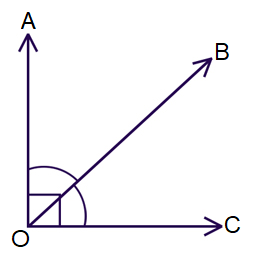
∠AOB + ∠BOC = 90˚
Find the value of x in each right angle.
Problem 1 :
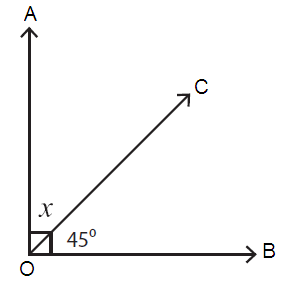
Solution :
The sum of the measures of complementary angles = 90˚.
Here, ∠AOC = x and ∠COB = 45˚
∠AOC + ∠COB = 90˚
x + 45˚ = 90˚
x = 90˚ – 45˚
x = 45˚
So, the value of x is 45˚.
Problem 2 :
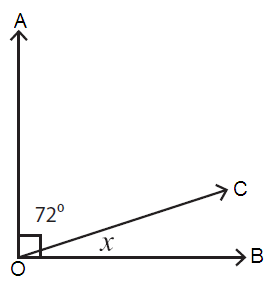
Solution :
The sum of the measures of complementary angles = 90˚.
Here, ∠AOC = 72˚ and ∠COB = x
∠AOC + ∠COB = 90˚
72˚ + x = 90˚
x = 90˚ - 72˚
x = 18˚
So, the value of x is 18˚.
Problem 3 :
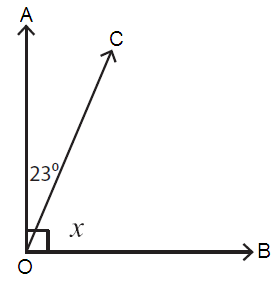
Solution :
The sum of the measures of complementary angles = 90˚.
Here, ∠AOC = 23˚ and ∠COB = x
∠AOC + ∠COB = 90˚
23˚ + x = 90˚
x = 90˚ - 23˚
x = 67˚
So, the value of x is 67˚.
Problem 4 :
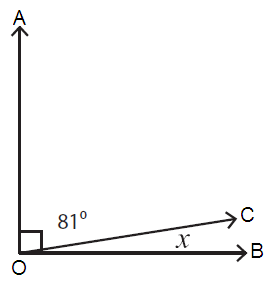
Solution :
The sum of the measures of complementary angles = 90˚
Here, ∠AOC = 81˚ and ∠COB = x
∠AOC + ∠COB = 90˚
81˚ + x = 90˚
x = 90˚ - 81˚
x = 9˚
So, the value of x is 9˚.
Problem 5 :
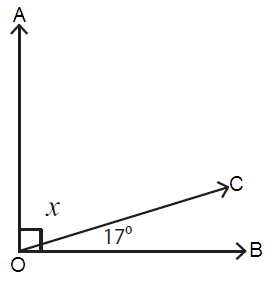
Solution :
The sum of the measures of complementary angles = 90˚.
Here, ∠AOC = x and ∠COB = 17˚
∠AOC + ∠COB = 90˚
x + 17˚= 90˚
x = 90˚ - 17˚
x = 73˚
So, the value of x is 73˚.
Problem 6 :
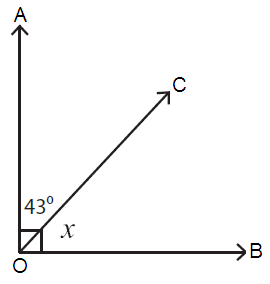
Solution :
The sum of the measures of complementary angles = 90˚.
Here, ∠AOC = 43˚ and ∠COB = x
∠AOC + ∠COB = 90˚
43˚ + x = 90˚
x = 90˚ - 43˚
x = 47˚
So, the value of x is 47˚.
Problem 7 :
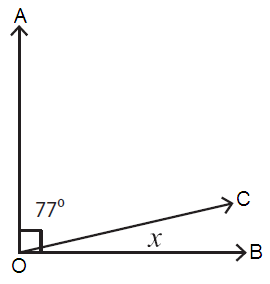
Solution :
The sum of the measures of complementary angles = 90˚.
Here, ∠AOC = 77˚and ∠COB = x
∠AOC + ∠COB = 90˚
77˚ + x = 90˚
x = 90˚ - 77˚
x = 13˚
So, the value of x is 13˚.
Problem 8 :
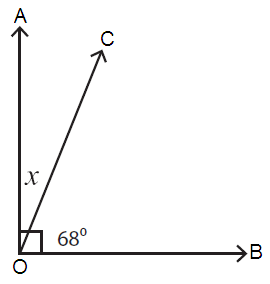
Solution :
The sum of the measures of complementary angles = 90˚.
Here, ∠AOC = x and ∠COB = 68˚
∠AOC + ∠COB = 90˚
x + 68˚ = 90˚
x = 90˚ - 68˚
x = 22˚
So, the value of x is 22˚.
Problem 9 :
When viewed from the side, the frame of a ball-return net forms a pair of supplementary angles with the ground. Find m∠BCE and m∠ECD.
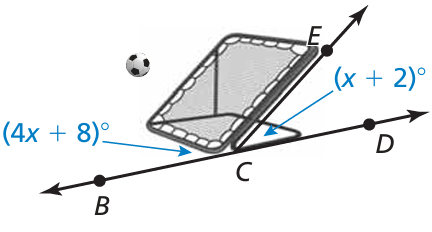
Solution :
∠BCE = 4x + 8
∠ECD = x + 2
∠BCE + ∠ECD = 180
4x + 8 + x + 2 = 180
5x + 10 = 180
5x = 180 - 10
5x = 170
x = 170/5
x = 34
Applying the value of x,
- ∠BCE = 4(34) + 8 ==> 136 + 8 ==> 144
- ∠ECD = 34 + 2 ==> 36
Problem 10 :
∠LMN and ∠PQR are complementary angles. Find the measures of the angles when m∠LMN = (4x − 2)° and m∠PQR = (9x + 1)°.
Solution :
Since m∠LMN and m∠PQR are complementary angles, then their sum will become 90 degree.
m∠LMN + m∠PQR = 90
(4x − 2)° + (9x + 1)° = 90
13x - 1 = 90
13x = 90 + 1
13x = 91
x = 91/13
x = 7
Applying the value of x, we get
|
m∠LMN = (4x − 2)° = 4(7) - 2 = 28 - 2 = 26 |
m∠PQR = (9x + 1)° = 9(7) + 1 = 63 + 1 = 64 |
Problem 11 :

a) Name a pair of adjacent complementary angles.
b) Name a pair of adjacent supplementary angles.
Solution :
a) Complementary angles :
If the sum of two angles is 90 degree, then they are complementary angles.
∠LJM and ∠MJN
are adjacent complementary angles.
b) ∠KJL and ∠LJN are supplementray angles.
Find the measure of each angle.
Problem 12 :
Two angles form a linear pair. The measure of one angle is twice the measure of the other angle.
Solution :
Let x be the measure of other angle, the measure of one angle will be 2x. For linear pair, the sum of pairs of angles will be 180.
2x + x = 180
3x = 180
x = 180/3
x = 60
Problem 13 :
Two angles form a linear pair. The measure of one angle is 1/3 the measure of the other angle.
Solution :
Let x be the measure of other angle, then one angle will be 1/3 of x
x + 1/3 of x = 180
x + x/3 = 180
(3x + x)/3 = 180
4x/3 = 180
x = 180 (3/4)
x = 135
1/3 of x = 135/3 ==> 45
So, the required angles are 45 and 135.
Problem 14 :
The measure of an angle is nine times the measure of its complement.
Solution :
Let x be the measure of an angle.
The other angle = 9(90 - x)
x = 9(90 - x)
x = 810 - 9x
x + 9x = 810
10x = 810
x = 810/10
x = 81
90 - x ==> 90 - 81 ==> 9
So, the required angles are 9 and 81.
Subscribe to our ▶️ YouTube channel 🔴 for the latest videos, updates, and tips.
Recent Articles
-
Finding Range of Values Inequality Problems
May 21, 24 08:51 PM
Finding Range of Values Inequality Problems -
Solving Two Step Inequality Word Problems
May 21, 24 08:51 AM
Solving Two Step Inequality Word Problems -
Exponential Function Context and Data Modeling
May 20, 24 10:45 PM
Exponential Function Context and Data Modeling